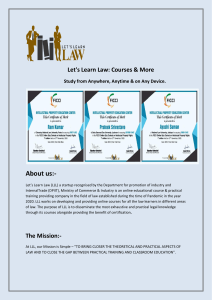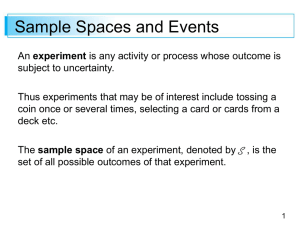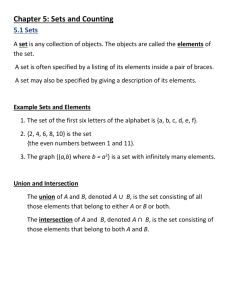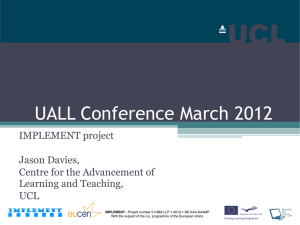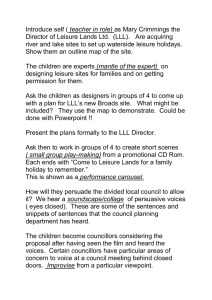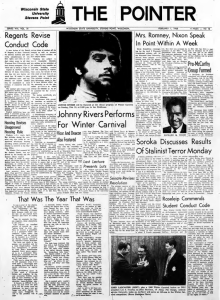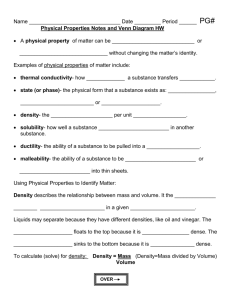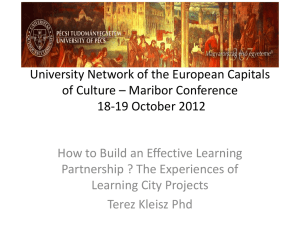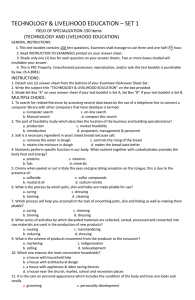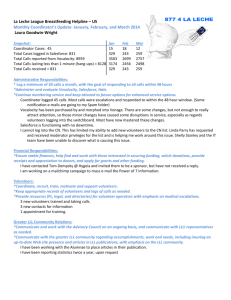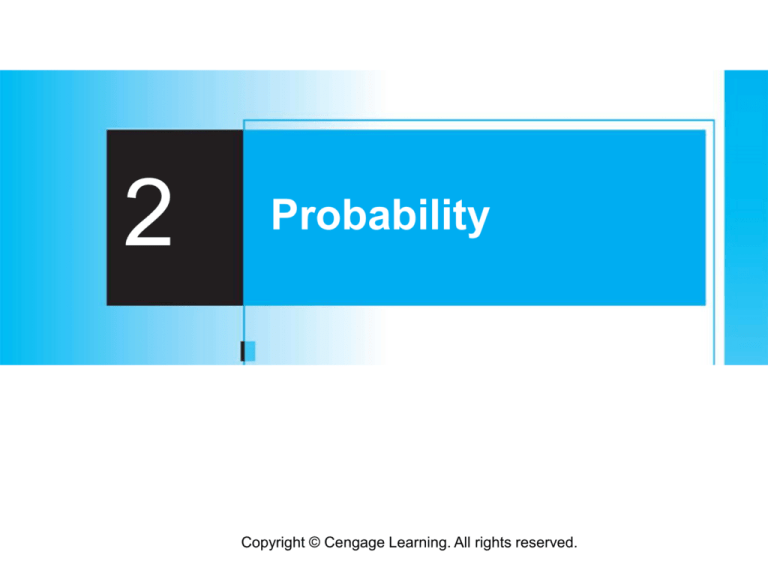
2
Probability
Copyright © Cengage Learning. All rights reserved.
2.1
Sample Spaces and Events
Copyright © Cengage Learning. All rights reserved.
Sample Spaces and Events
An experiment is any activity or process whose outcome is
subject to uncertainty.
Although the word experiment generally suggests a
planned or carefully controlled laboratory testing situation,
we use it here in a much wider sense.
Thus experiments that may be of interest include tossing a
coin once or several times, selecting a card or cards from a
deck, weighing a loaf of bread, ascertaining the commuting
time from home to work on a particular morning, obtaining
blood types from a group of individuals, or measuring the
compressive strengths of different steel beams.
3
The Sample Space of an Experiment
4
The Sample Space of an Experiment
Definition
The sample space of an experiment, denoted by
set of all possible outcomes of that experiment.
, is the
5
Example 1
The simplest experiment to which probability applies is one
with two possible outcomes.
One such experiment consists of examining a single fuse to
see whether it is defective.
The sample space for this experiment can be abbreviated
as = {N, D}, where N represents not defective,
D represents defective, and the braces are used to
enclose the elements of a set.
6
Example 1
cont’d
Another such experiment would involve tossing a
thumbtack and noting whether it landed point up or point
down, with sample space = {U, D}, and yet another would
consist of observing the gender of the next child born at the
local hospital, with = {M, F}.
7
Events
8
Events
In our study of probability, we will be interested not only in
the individual outcomes of but also in various collections
of outcomes from .
Definition
An event is any collection (subset) of outcomes contained
in the sample space .
An event is simple if it consists of exactly one outcome and
compound if it consists of more than one outcome.
9
Events
When an experiment is performed, a particular event A is
said to occur if the resulting experimental outcome is
contained in A.
In general, exactly one simple event will occur, but many
compound events will occur simultaneously.
10
Example 5
Consider an experiment in which each of three vehicles
taking a particular freeway exit turns left (L) or right (R) at
the end of the exit ramp.
The eight possible outcomes that comprise the sample
space are LLL, RLL, LRL, LLR, LRR, RLR, RRL, and RRR.
Thus there are eight simple events, among which are
E1 = {LLL} and E5 = {LRR}.
11
Example 5
cont’d
Some compound events include
A = {LLL, LRL, LLR} = the event that exactly one of the
three vehicles turns right
B = {LLL, RLL, LRL, LLR} = the event that at most one of
the vehicles turns right
C = {LLL, RRR} = the event that all three vehicles turn in
the same direction
12
Example 5
cont’d
Suppose that when the experiment is performed, the
outcome is LLL.
Then the simple event E1 has occurred and so also have
the events B and C (but not A).
13
Some Relations from Set Theory
14
Some Relations from Set Theory
An event is just a set, so relationships and results from
elementary set theory can be used to study events.
The following operations will be used to create new events
from given events.
Definition
1. The complement of an event A, denoted by A, is the set
of all outcomes in that are not contained in A.
15
Some Relations from Set Theory
2. The union of two events A and B, denoted by A B and
read “A or B,” is the event consisting of all outcomes that
are either in A or in B or in both events (so that the union
includes outcomes for which both A and B occur as well
as outcomes for which exactly one occurs) that is, all
outcomes in at least one of the events.
3. The intersection of two events A and B, denoted by
A B and read “A and B,” is the event consisting of all
outcomes that are in both A and B.
16
Example 8
For the experiment in which the number of pumps in use at
a single six-pump gas station is observed,
let A = {0, 1, 2, 3, 4}, B = {3, 4, 5, 6}, and C = {1, 3, 5}.
Then
A = {5, 6},
A B = {0, 1, 2, 3, 4, 5, 6} =
A C = {0, 1, 2, 3, 4, 5},
A B = {3, 4},
A C = {1, 3},
(A C) = {0, 2, 4, 5, 6}
,
17
Some Relations from Set Theory
Sometimes A and B have no outcomes in common, so that
the intersection of A and B contains no outcomes.
Definition
Let denote the null event (the event consisting of no
outcomes whatsoever).
When A B = , A and B are said to be mutually
exclusive or disjoint events.
18
Example 10
A small city has three automobile dealerships: a GM dealer
selling Chevrolets and Buicks; a Ford dealer selling Fords
and Lincolns; and a Toyota dealer.
If an experiment consists of observing the brand of the next
car sold, then the events A = {Chevrolet, Buick} and
B = {Ford, Lincoln} are mutually exclusive because
the next car sold cannot be both a GM product and a Ford
product (at least until the two companies merge!).
19
Some Relations from Set Theory
The operations of union and intersection can be extended
to more than two events.
For any three events A, B, and C, the event A B C is
the set of outcomes contained in at least one of the three
events, whereas A B C is the set of outcomes
contained in all three events.
Given events A1, A2, A3 ,..., these events are said to be
mutually exclusive (or pairwise disjoint) if no two events
have any outcomes in common.
20
Some Relations from Set Theory
A pictorial representation of events and manipulations with
events is obtained by using Venn diagrams.
To construct a Venn diagram, draw a rectangle whose
interior will represent the sample space .
Then any event A is represented as the interior of a closed
curve (often a circle) contained in .
21
Some Relations from Set Theory
Figure 2.1 shows examples of Venn diagrams.
Venn diagrams
Figure 2.1
22

